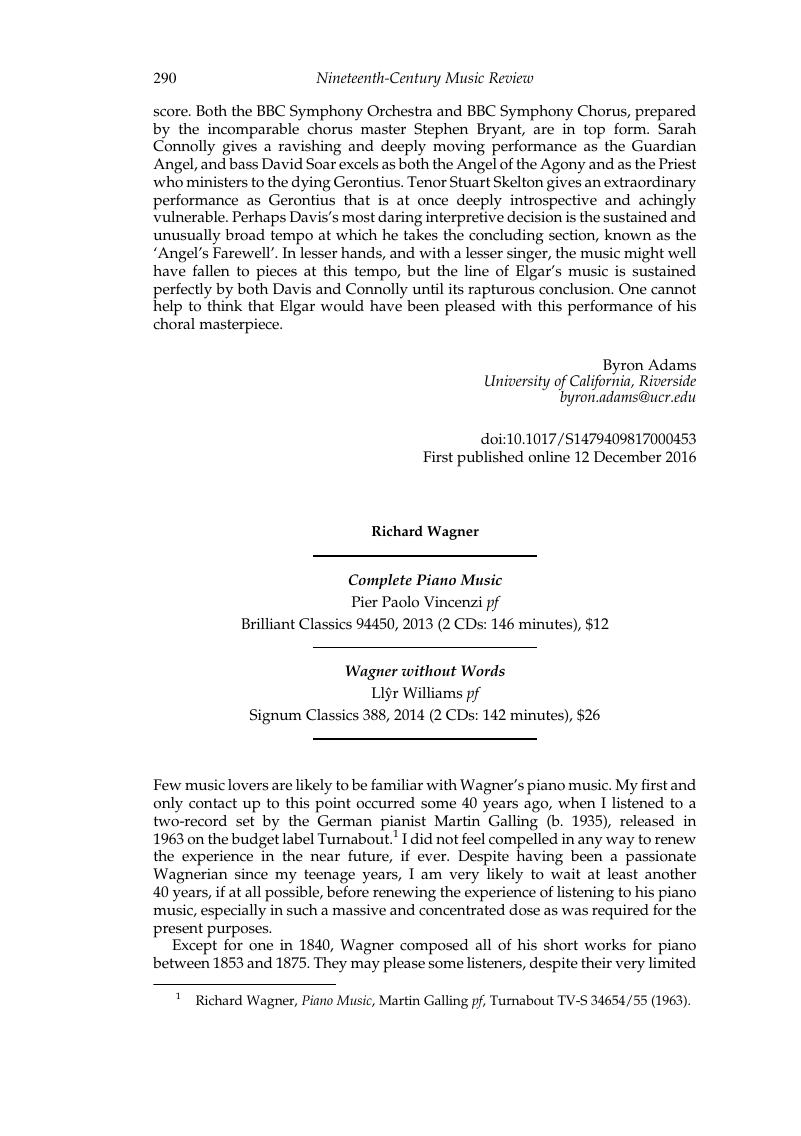No CrossRef data available.
Article contents
Richard Wagner - Complete Piano Music - Pier Paolo Vincenzi pf - Brilliant Classics 94450, 2013 (2 CDs: 146 minutes), $12 - Wagner without Words - Llŷr Williams pf - Signum Classics 388, 2014 (2 CDs: 142 minutes), $26
Published online by Cambridge University Press: 06 November 2017
Abstract

- Type
- CD Reviews
- Information
- Copyright
- © Cambridge University Press 2017
References
1 Richard Wagner, Piano Music, Martin Galling pf, Turnabout TV-S 34654/55 (1963).
2 Wagner, Richard, Klavierwerke zu zwei und vier Händen: Gesamtausgabe (Mainz: Schott, 1981)Google Scholar.
3 The autograph of the solo version of the Polonaise (but not its trio), plus an edition of the entire piece, can be found in Furness, R.S. and Walker, Arthur D., ‘A Wagner Polonaise’, The Musical Times 114/1559 (1973): 26–27 CrossRefGoogle Scholar.
4 The fugue (not included in the practical edition) is found in the critical report of the complete edition: Klavierwerke, ed. Carl Dahlhaus, vol. 19 of Sämtliche Werke (Mainz: Schott, 1970): 115.
5 An edition by Nina Kavtaradze of the one-page Notenbrief is available online at www.onlinesheetmusic.com/notenbrief-fur-mathilde-wesendonck-piano-p326464.aspx.
6 For a facsimile of the manuscript, with full details on its composition, see Matter, Jean, ‘Une page inconnue de Richard Wagner’, Revue musicale suisse 116/1 (1976): 25–26 Google Scholar. The piece was included in Luchino Visconti’s film Ludwig (1973), performed on the piano by the conductor Franco Mannino, then played by the orchestra in the latter’s transcription.
7 A facsimile was printed in Richard Wagner an Mathilde Wesendonk [sic]: Tagebuchblätter und Briefe, 1853–1871 (Berlin: Alexander Duncker Verlag, 1910; first ed., 1904), at the end of the book (with reference to letter no. 98 on pp. 201–2).
8 Liszt’s transcriptions of Wagner are included in the Neue Liszt-Ausgabe, series 2, vols 10, 11, 12, 13, 15, 23 and 24 (Editio Musica Budapest). A one-volume edition (reprinted from vol. 3, part 1) of Liszt’s transcriptions under the editorship of Konstantin Sorokin (Moscow: State Music Publishers, 1961) is available as Liszt, Franz, Complete Piano Transcriptions from Wagner’s Operas, ed. Charles Suttoni (New York: Dover Publications, in association with the American Liszt Society, 1981)Google Scholar.
9 Columbia Masterworks M32351 (1973), reissued on CD in The Glenn Gould Legacy, vol. 3, CBS Records M3K42107 (1986).
10 The three scores are available as part of the Virtuoso Piano Transcription Series from Schott: Siegfried-Idyll (WWV 103) in einer Klaviertranskription von Glenn Gould (no. 5, 2003; ED 9546), Die Meistersinger von Nürnberg (Vorspiel) in einer Klaviertranskription zu zwei Händen oder für zwei Klaviere zu vier Händen von Glenn Gould (no. 6, 2003; ED 9547), and Morgendämmerung und Siegfrieds Rheinfahrt (Götterdämmerung) in einer Klaviertranskription von Glenn Gould (no. 7, 2004; ED 9548).
11 In Tables 1 and 2, the bar numbers of Götterdämmerung and Parsifal refer to the vocal scores based on the complete editions published by Schott (ED 20550, 2013; ED 20545, 2012).


